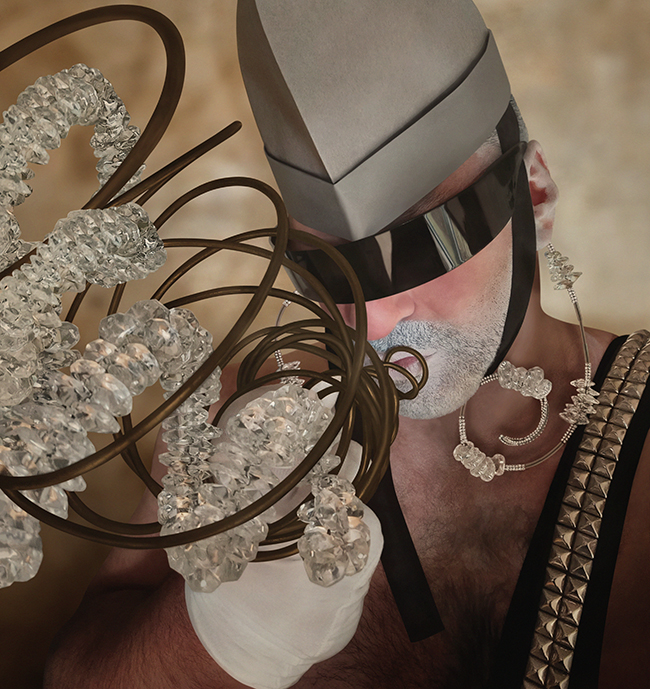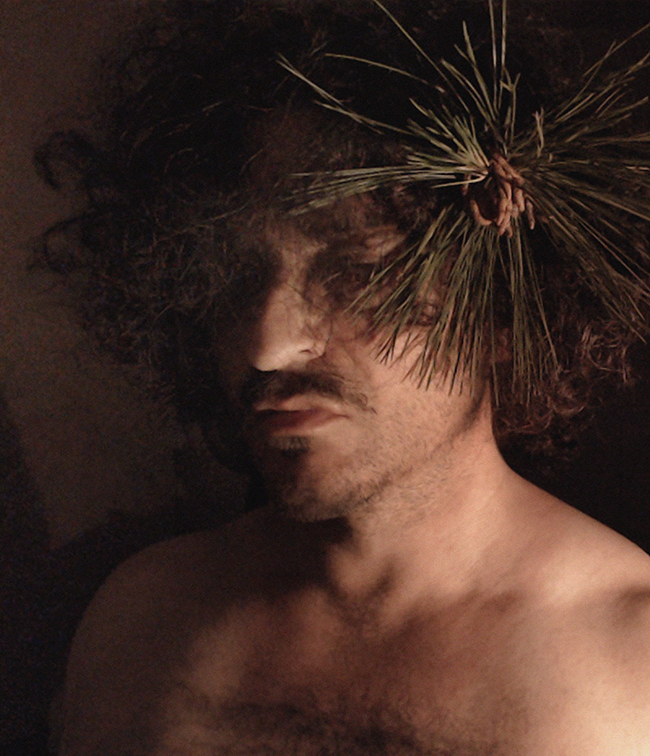Born in Montreal in 1964, Adamo Macri is a multimedia artist who doesn’t seem to worry about staying in one lane. He studied commercial art, graphic design, photography, art history, and fine arts at Dawson College. That mix of training comes through in his work—he moves between sculpture, photography, drawing, video, and painting without hesitation. Though he’s often described as a sculptor, it’s not the full picture. Macri builds his work around layered references, both historical and streetwise, mythological and modern. His pieces aren’t just visual—they’re linguistic and conceptual. You look at them, but you also have to think through them. And sometimes, you laugh, flinch, or double back. His use of photography often presents like sculpture—fixed, direct, and loaded with symbolic intent.
Let’s look at three of Macri’s pieces. Each one carries a specific title that acts like bait. You think you know what it means, then it turns into something else.

Male Head with Bugle (2024)
Photography, 84 x 89 cm
At first glance, Male Head with Bugle seems straightforward: a portrait featuring a head and a horn. But Macri never settles for just visual accuracy. The “bugle” in the title does more than name a musical instrument. The word carries weight—military history, battlefield signaling, ceremonial calls. It’s brass, loud, and loaded. But there’s another side too. On the street, “bugle” is slang. In Cockney rhyming slang, it means “nose.” In drug slang, it hints at cocaine.
This twisting of meaning is exactly what Macri wants. The photograph presents a head—calm, formal, almost classical—but the bugle becomes a visual pun. Is the figure a herald or a victim? A soldier or a partygoer? Is he announcing something, or has he just sniffed something? The work makes you hover between interpretations, and that friction becomes the point. Kenneth Radu, in his essay “Tricky Titles,” points to Macri’s tendency to embed multiple meanings into simple phrases. In this case, language is as sculptural as the image. The photo holds still, but the title keeps moving.

Aerosol (2024)
Photography, 84 x 89 cm
This piece continues Macri’s interest in words that float between worlds. “Aerosol” suggests a pressurized spray can—maybe hairspray, maybe paint. But visually, the photo feels more anchored. There’s a person in it, again posed in a controlled, composed way. Still, the idea of aerosol lingers in the air, metaphorically and literally.
In urban art, aerosol means graffiti. It’s how street artists work, especially those who operate anonymously or illegally. The title nudges you to think of Banksy, of the tension between vandalism and public expression. At the same time, “aerosol” also has associations with pollution, cosmetic enhancement, and even disease transmission. It’s about what gets released into the air—what’s invisible but still acts on the world.
Macri uses the image to bring those themes together. The body in the photo looks contained, posed, fixed. But the title implies diffusion, leakage, action. Again, it’s a study in contrast. The photo seems polished, formal, even traditional—but the language gives it an edge. You end up questioning what’s really being sprayed, and what’s actually being framed.

Pinus Attis (2013)
Photography, 41 x 48 cm
This piece goes deeper into myth. The title refers to Attis, a Phrygian deity tied to the cycles of death and rebirth. His story is a violent one—castration, transformation, and resurrection. According to myth, he becomes a pine tree, hence the “Pinus” in the title.
In this photo, the myth is quiet, almost hidden. The subject is a figure, again formally posed. There’s a bodily stillness to it, but also an underlying tension. You can feel that something has happened or is about to. If you know the story of Attis, that pressure becomes clearer. The pine tree wasn’t just a symbol—it was a tomb, a transformation, a release.
Macri doesn’t illustrate the myth. He invokes it. The result is a portrait that doubles as a ritual. The figure becomes more than human. It becomes part of a seasonal story—cut down, re-rooted, waiting to return. The photograph becomes a mirror to an older narrative, one that still haunts contemporary life.
Across these three works, Macri stays consistent in his approach. The photography isn’t decorative. It’s coded. Each title becomes part of the piece, a clue and a trap. The subjects are often still, but the meaning is not. He uses art to stage collisions—between language and body, myth and slang, permanence and change. What looks simple always turns out to be something else. That’s the trick, and the invitation.

